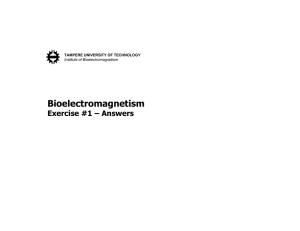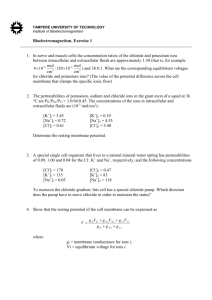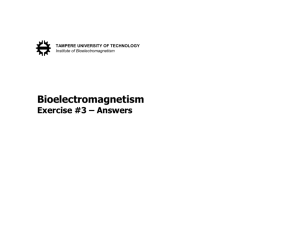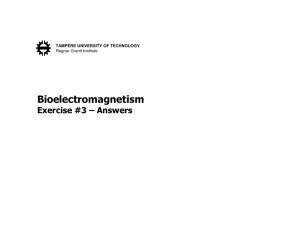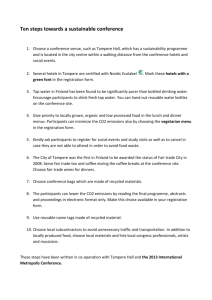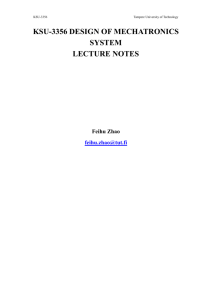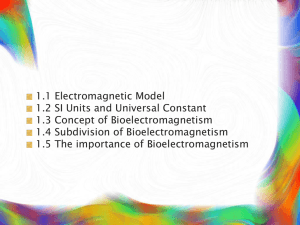ans1 - Bioelectromagnetism
advertisement
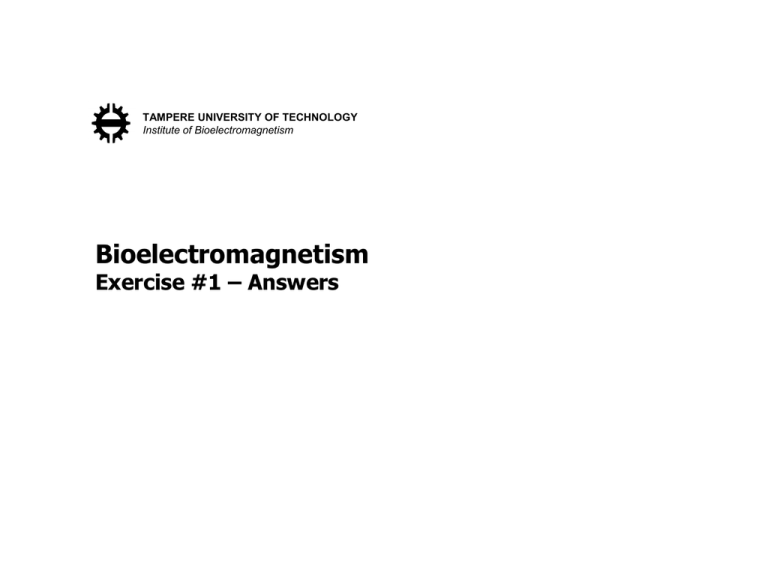
TAMPERE UNIVERSITY OF TECHNOLOGY Institute of Bioelectromagnetism Bioelectromagnetism Exercise #1 – Answers Q1: Equilibrium Voltages In nerve and muscle cells the concentration ratios of the chloride and potassium ions between intracellular and extracellular fluids are approximately 1:30 (that is, for example 4x10-6 : 120x10-6 mol/cm3) and 38.8:1. What are the corresponding equilibrium voltages for chloride and potassium ions? (The value of the potential difference across the cell membrane that clamps the specific ionic flow) Bioelectromagnetism Exercise 1 TAMPERE UNIVERSITY OF TECHNOLOGY Institute of Bioelectromagnetism Q1: Equilibrium Voltages Nernst equation separately for both ion types R T ci V ln zF c o R = 8.314 J/(mol*K) T = 37C = 273 + 37 K = 310 K F = 9.649*104 C/mol For Cl-: 8.314*310 1 VCl ln = -90.9 mV -1*96485 30 For K+ : – ci/co = 38.8 / 1 – z = +1 VK = -97.7 mV Bioelectromagnetism Exercise 1 TAMPERE UNIVERSITY OF TECHNOLOGY Institute of Bioelectromagnetism Q2: Resting Membrane Potential The permeabilities of potassium, sodium and chloride ions in the giant axon of a squid at 36 °C are PK:PNa:PCl = 1:0.04:0.45. The concentrations of the ions in intracellular and extracellular fluids are [10-3 mol/cm3]: [K+]i = 3.45 [Na+]i = 0.72 [Cl-]i = 0.61 [K+]o = 0.10 [Na+]o = 4.55 [Cl-]o = 5.40 Determine the resting membrane potential. Bioelectromagnetism Exercise 1 TAMPERE UNIVERSITY OF TECHNOLOGY Institute of Bioelectromagnetism Q2: Resting Membrane Potential Background – permeability differs among ions species – > selective permeability -> concentration gradients - > GHK-equation – Nernst for one ion type. Goldman-Hodgin-Katz for several ion types: P c P c P c R T K i, K Na i, Na Cl o,Cl Vm ln P c F P c P c K o , K Na o , Na Cl i ,Cl ? Bioelectromagnetism Exercise 1 R = 8.314 J/(mol*K) F = 96485 J/mol T = 309 K TAMPERE UNIVERSITY OF TECHNOLOGY Institute of Bioelectromagnetism Q2: Resting Membrane Potential Resting membrane potential: P c P c P c R T K i, K Na i, Na Cl o,Cl V ln P c F P c P c K o , K Na o , Na Cl i ,Cl ? i) NO z ii) == Nernst eq for K, if cNa, Cl =0 iii) equilibrium = JK + JNa + JCl = 0 RESULT : Vm = -0.0629 V -63 mV Bioelectromagnetism Exercise 1 TAMPERE UNIVERSITY OF TECHNOLOGY Institute of Bioelectromagnetism Q3: Chloride Pump A special single cell organism that lives in a natural mineral water spring has permeabilities of 0.09, 1.00 and 0.04 for the Cl-, K+ and Na+, respectively, and the following concentrations [Cl-]i = 178 [K+]i = 135 [Na+]i = 0.05 [Cl-]o = 0.47 [K+]o = 83 [Na+]o = 118 To maintain the chloride gradient, this cell has a special chloride pump. Which direction does the pump have to move chloride in order to maintain the status? Solution: pump will have to counteract the net force (C+E) – GHK = resting potential – Nernst for Cl- Bioelectromagnetism Exercise 1 TAMPERE UNIVERSITY OF TECHNOLOGY Institute of Bioelectromagnetism Q3: Chloride Pump P c P c P c R T K i, K N a i, N a C l o,C l V ln P c F P c P c K o , K N a o , N a C l i ,C l RMP (25 C°) ? V 6.8mV Nernst for Cl-: RT c i V Cl =ln 152mV zF c o Driving force ∆V = RMP - VCl= -158.8 mV – – negative ion: force to the outside Cl- leaking outside Answer: The pump must counteract driving force and pump chloride into the cell to maintain the chloride gradient. Bioelectromagnetism Exercise 1 TAMPERE UNIVERSITY OF TECHNOLOGY Institute of Bioelectromagnetism Q4: RMP Show that the resting potential of the cell membrane can be expressed as V where g V g V K K g V Na Na g g K g Na Cl Cl Cl gi = membrane conductance for ions i, Vi = equilibrium voltage for ions i. Bioelectromagnetism Exercise 1 TAMPERE UNIVERSITY OF TECHNOLOGY Institute of Bioelectromagnetism Q4: RMP When the membrane is at resting state: Ii = 0 IK + INa + ICl = 0 I=U/R, g=1/R E.g. for potassium: I K g KU g K (Vm VK ) For all currents: g K (Vm VK ) g Na (Vm VNa ) gCl (Vm VCl ) 0 Vm g V g V K K g V Na Na g g K g Na Cl Cl Cl Bioelectromagnetism Exercise 1 TAMPERE UNIVERSITY OF TECHNOLOGY Institute of Bioelectromagnetism Q5: Synapse Figure 1 represents an electrical model of a synapse. When impulse arrives to the presynaptic terminal the transmitter (acetylcholine ACH) is released to the synaptic cleft (after 0.5 ms). The cell membrane will become permeable to Na+ and K+ ions and the membrane potential tends to shift towards the mean of the Nernst voltages of the Na+ and K+ ions (=reversal voltage Vrev). a) What is the resting potential of the presynaptic terminal (ACH-switch open)? b) What is the reversal voltage, Vrev (ACH-switch closed)? Cm (membrane capacitance per area) = 1 µF/cm2 Nernst voltages VK = -100 mV and VNa = 60 mV RK = 108 Ω, RNa = 1.5*109 Ω, RK = 105 Ω, RNa = 105 Ω. Bioelectromagnetism Exercise 1 TAMPERE UNIVERSITY OF TECHNOLOGY Institute of Bioelectromagnetism Q5: Synapse Information from neuron to another flows across a synapse. The synapse consists of: – a presynaptic ending (contains neurotransmitters), – a postsynaptic ending that contains receptor sites for neurotransmitters and, – the synaptic cleft: a space between Neurotransmitters – chemicals that cross the synapse between two neurons – Gi Bioelectromagnetism Exercise 1 TAMPERE UNIVERSITY OF TECHNOLOGY Institute of Bioelectromagnetism Q5: Synapse a) What is the resting potential of the presynaptic terminal (ACH-switch open)? – Ignored: Na-K pumps Leagage I (~ICl) – steady-state: iK+iNa = 0 iK = GK(Vm-VK) iNa = GNa(Vm-VNa) GK(Vm-VK)=-GNa(Vm-VNa) Vm = (GNaVNa + GKVK)/(GK+GNa) Bioelectromagnetism Exercise 1 TAMPERE UNIVERSITY OF TECHNOLOGY Institute of Bioelectromagnetism Q5: Synapse Convert from R to G: RK = 108 Ω => GK = 1/RK = 10-8 S RNa = 1.5*109 Ω => GNa = 6.7*10-10 S VNa = 60 mV VK = -100 mV Vm = (GNaVNa + GKVK)/(GK+GNa) = -90mV Bioelectromagnetism Exercise 1 TAMPERE UNIVERSITY OF TECHNOLOGY Institute of Bioelectromagnetism Q5: Synapse b) What is the reversal voltage, Vrev (ACH-switch closed)? I=0 after the release of ACH iK+iNa = 0 iK = (GK + GK)*(Vr-VK)= G’K *(Vr-VK) iNa = (GNa + GNa) *(Vr-VNa)= G’Na *(Vr-VNa) G’K*(Vr-VK)=- G’Na*(Vr-VNa) Vr = (G’NaVNa + G’KVK)/(G’K+ G’Na) Bioelectromagnetism Exercise 1 TAMPERE UNIVERSITY OF TECHNOLOGY Institute of Bioelectromagnetism Q5: Synapse Vr = (G’NaVNa + G’KVK)/(G’K+ G’Na) G’Na = GNa + GNa G’K = GK + GK RK = 105 Ω => GK = 10-5 S RNa = 105 Ω => GNa = 10-5 S GK = 10-8 S GNa = 6.7*10-10 S G’K = 1.0011*10-5 S G’Na = 1.0001*10-5 S VNa = 60 mV VK = -100 mV ' GNa VNa VK ' G Vr K ' GNa 1 ' GK ' GNa 1 ' GK Vr Bioelectromagnetism Exercise 1 VNa VK 20mV 2 TAMPERE UNIVERSITY OF TECHNOLOGY Institute of Bioelectromagnetism
